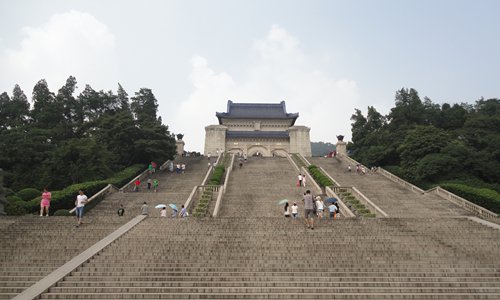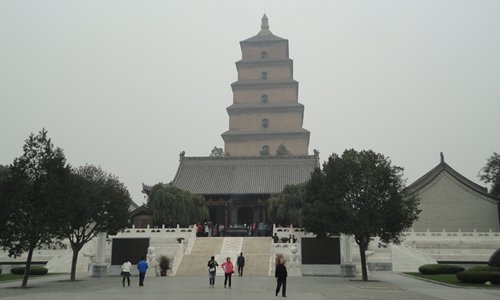
Sun Yat-sen Mausoleum in Nanjing, East China's Jiangsu Province (Photo/Hilton Yip)

The Giant Goose Pagoda in Xi'an, Shaanxi Province (Photo/Hilton Yip)
Beijing, as almost everyone knows, is the capital of China. Large, proud and historic, it boasts a history of over 1,000 years and sights that are famous across the world.
But it is not ancient China's only great capital. Three other illustrious cities also had the honor of being great Chinese capitals where powerful emperors lived and ruled.
The city of Chang'an, modern day Xi'an, shone as the capital of the -il-lustrious Tang Dynasty (618-907), while to the east, Luoyang, was the seat of power for Western Han Dynasty (206BC-AD25). Along the Yangtze River, Nanjing, the "Southern Capital," preceded Beijing as the capital of the Ming Dynasty (1368-1644) and was later the capital of the Republic of China (1912-49). They have somewhat different atmospheres, but all are intriguing places to visit, boasting a multitude of famous landmarks, historic places and UNESCO World Heritage Sites.
'Southern Capital'
Let's start with Nanjing, the modern-day capital of Jiangsu Province, located along the Yangtze River. With its well laid-out streets shaded by French parasol trees and lakes and hills, it is arguably China's most attractive major city. It is filled with history and even tragedy, but is not suffocated by it.
As a former imperial and republican capital, it is fitting that Nanjing is the resting place of two of China's most famous leaders, Sun Yat-sen and the Hongwu Emperor, the first emperor of the Ming Dynasty. Conveniently, the tombs of the father of modern China and the Ming Dynasty founder are both located on the Purple Mountain, or Zijin Shan, which overlooks the city and is home to numerous historical sites.
The Ming Emperor Tomb features an impressive "Spirit Way" (or shendao) - a path with pairs of guardian stone statues of animals such as tigers and the mythical unicorn-like qilin on either side of the path that leads to the tomb. The Sun Yat-sen Mausoleum lies atop a wide stone stairway fronted by a paifang, or memorial arch. The blue-roofed main hall that overlooks the city is an appropriate resting place for the adored Sun.
Lying just south of the mountain is Xuanwu Lake, along which part of the 600-year-old city wall is located. Nanjing is one of the few cities in the world which still features a significant portion of its ancient city wall. However, the largest existing part of this wall is further south at Zhonghuamen, where you can walk on top of it.
The city's most bustling attraction is the Confucius Temple, or Fuzimiao, which, despite the name, includes not only a temple but the surrounding environs and historic sites such as the Examination Hall and loads of restaurants, shops and vendors as well.
Many of China's most famous officials and scholars passed their official exams in the hall.
If you want to see up close a vivid reminder of Nanjing's status as capital during the Republic of China (ROC) period, the Presidential Palace is the ideal venue.
Besides housing the office of the ROC president from 1927 to 1949, the giant compound also features government buildings that housed ministries, elegant Chinese gardens and a traditional worship hall.
However, Nanjing's important status also made it the site of some severe battles in the past, including during the Taiping Rebellion in the mid-19th century and the Japanese invasion during World War II. As a result, many of its historic sites such as the Ming Imperial Palace were destroyed.
But the most notorious tragedy took place in 1937 when Japanese troops stormed the city and mass killed and raped its citizens. This massacre, in which an estimated 300,000 civilians were murdered, is commemorated at the Nanjing Massacre Memorial, which is a somber museum that pays tribute to the victims, both living and dead.
Despite all the history and landmarks, it is Nanjing's Xuanwu Lake, Purple Mountain, forest parks and tree-lined boulevards that give it a special charm that is often lacking in many other Chinese cities.


















































